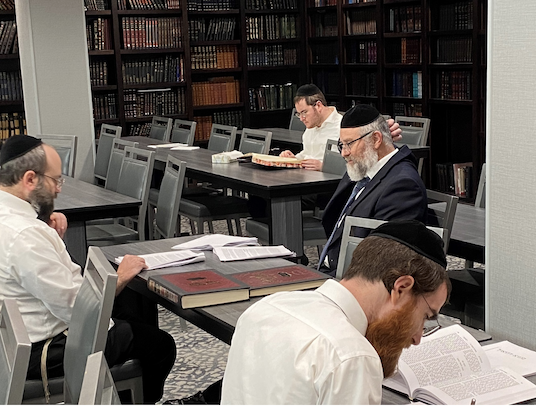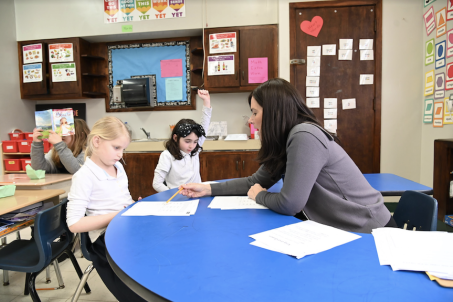The world keeps on changing, and its effects are everywhere. A perfect example of this is how play has changed in recent years for our youngest children. Early childhood educators are now seeing a generation of children who do not have the same skill set as previous generations when entering preschool. So, what can be done to offset the new concept of play?
This week’s workshop was given by Mrs. Sherra Bloomenkranz, a registered and license occupational therapist. She explored this issue in depth and provided a toolbox of strategies to supplement what is now considered play. Her presentation consisted of answering three questions:
- What caused the change in play?
- What are the skill areas of concern?
- What are valuable games for the classroom that will build up children developmentally and neurologically?
Major causes of recent changes in how kids play and their effects:
- Safety concerns are one cause of changes in kids’ play patterns. These include putting babies to sleep on their sides/backs instead of their stomachs and the removal of certain climbing apparatus at the park playgrounds. Both have caused the lack of muscle-building experiences that were once a mainstay of child development.
- Technology is an obvious dramatic change to kids’ daily lives. Many children sit for longer periods of time watching a video or playing with a device. Teachers today tend to spend more time demonstrating, causing a lack of first-hand experiences for the child.
Skill areas of concern:
Body and space – awareness of one’s body and limbs in the surrounding space is a key skill for young children. These skills are associated with vision. Teachers today need to add the dimension of vision to help kids progress out of the two-dimensional world and create a larger picture of a child’s world. This is easy to do in kindergarten and early grades. For example, give a child directions to get papers from a back shelf in the room but do not point. Let the child figure out what to do or ask you questions about the instructions.
Figure/ground perception – the ability to differentiate an object from its background. Children who struggle with this skill often have trouble learning to read, particularly as their books feature an increasing number of words on each page. It’s also hard for them to scan text for relevant information. An activity to help children is to let the child experience a mess so he/she can differentiate objects into groups.
Time and space continuum – The universe can be viewed as having three space dimensions — up/down, left/right, forward/backward — and one time dimension. This four-dimensional space is referred to as the space-time continuum. Children do struggle with the concepts of time and space. Due to digital clocks, children lose the concept of time passing. They often confuse “yesterday” with “a long time ago.” Analog clocks show the passage of time more visually than digital clocks. In addition, children cannot sit long enough to finish a project/skill and be proficient at the project/skill. Mastery takes time to achieve. Because children are used to instant gratification today, they lose the concept of the time and space continuum. Making things that are layered is a phenomenal way to learn about space. Glue items on top of other items to give an added-up dimension (instead of the two-dimensional simpler framework). Often, it is about the process, not the finished product.
Muscle strength and eye-hand coordination – Children are constantly exploring their bodies and their world. They are holding different things today and using different muscles to hold them which do not require the same muscle effort and strength. This has led to weakness in hands, less endurance when writing, and difficulty pulling up socks/pants. Also, many manipulatives have been removed from early childhood environments due to choking hazards. Try to build up muscles with allowable manipulatives.
Motor skills – Goal-oriented play activity in early childhood improves motor skills. Children need intrinsic muscle development. This can be accomplished with wrist play, movement of rattles, bells, hand muscles and finger muscles. This affects later writing endurance, the transition from writing large letters to writing smaller letters, typing, and sewing.
Texture experience – Learning through touch and texture is also very important due to the fact that it strengthens a child’s motor skills. For instance, gripping, holding, squeezing, stacking, poking, pouring or scooping will help children strengthen the muscles in their body and also helps them to develop stronger hand-eye coordination. Children need to experience the differences in textures and “smoosh” the textures in their hands. Good items to use are play dough, sand tables, shaving cream, slime, and water tables.
Left/right dominance, crossing the midline – Crossing the midline happens when a child moves his/her hand or foot across this line to work on the opposite side of his/her body. Before crossing the midline happens, a child will typically use only one side of their body at a time. For example, they’ll use their left hand only to play with a block on their left side. Activities that provide opportunities for children to cross the midline reinforce the pathways between the brain’s hemispheres and allow for the fundamentals of fine motor skills, such as the development of their dominant hand, as well as enhancing a child’s coordination and learning. Teachers should encourage these skills which are needed for tracking in reading and language.
Valuable games for the classroom that will build up children developmentally and neurologically
Board games – Break the game down as to what skills it can teach your students, i.e., physical, visual, and social. For example, the materials and game pieces require skills – card sequences, higher level visual skills, nicely picking one card, shuffling the deck, making neat piles, one-on-one counting as a piece is moved on the board, waiting one’s turn, giving others a chance to move their pieces, noting that someone wins and someone does not win, using groups of four vs. groups of two.
Using different media to help kids today learn through play:
Liquid glue – Squirt a little onto a “Pringles” cap or paper. Let the child pick up the item to be glued, dip it into the glue, and actually glue the item. This is great for fine motor skill practice. It develops the pincer and pincer refinement. Put the pieces to be glued on the opposite side of where the child is sitting so he/she needs to cross the midline to get them. Mix glitter with glue and then use a paint brush to paint with it. When it dries, one just sees the glitter.
Glue sticks can help with refining the pencil grip skill.
Crayons – Broken crayons foster the tripod grasp and build up muscles.
Q tips with watercolors – This is a great way to teach letter writing. A box outlined with a crayon helps force the child to stay within a waxed boundary. One can also use strips of paper or a label to create a boundary.
Erasable pens in many colors – These are great for children who have sensory issues with pencils.
Activities with hands closed and grasping.
Activities for addressing dysregulation – Some children are missing physical movement and act out behaviorally. Provide physical movement for them.
Visual games – Require students to follow multi-step or vague directions where they need to put pieces together so they can think about the clues needed to create the big picture. Ask students to tell you about what they did in camp or use imagination games. Help students by letting them play with shopping carts – go “shopping” and do chores as they role-play to be adults. For example, I Spy especially requires them to leave their seats to find things.
Mrs. Bloomenkranz concluded her session by answering questions including:
- What is the role of fidgets and poppits in class today? These are mindless tools created by our current environment so children can sit and attend. If they are used quietly and are nondisruptive, a teacher can decide if they are allowable in the classroom. They do not really foster a missing skill.
- How can a teacher help parents prioritize play time for their children?
- The opportunity to play is not equal to signing up a child for soccer class. Parents should foster independence and self-initiation (self-starting skill) for their children to play.
- Also, stop rescuing children. Help them to figure out a situation for themselves – do not provide them with step-by-step answers.
- A set of pencils with 36 colors is not more therapeutic than 5 stubby markers.
Teachers walked away with an understanding that basic play skills in early childhood lay the groundwork for the developmental skills children need in their school experience. Furthermore, their role as educators is even more critical in this new environment, since children are missing skills now more than ever before.


